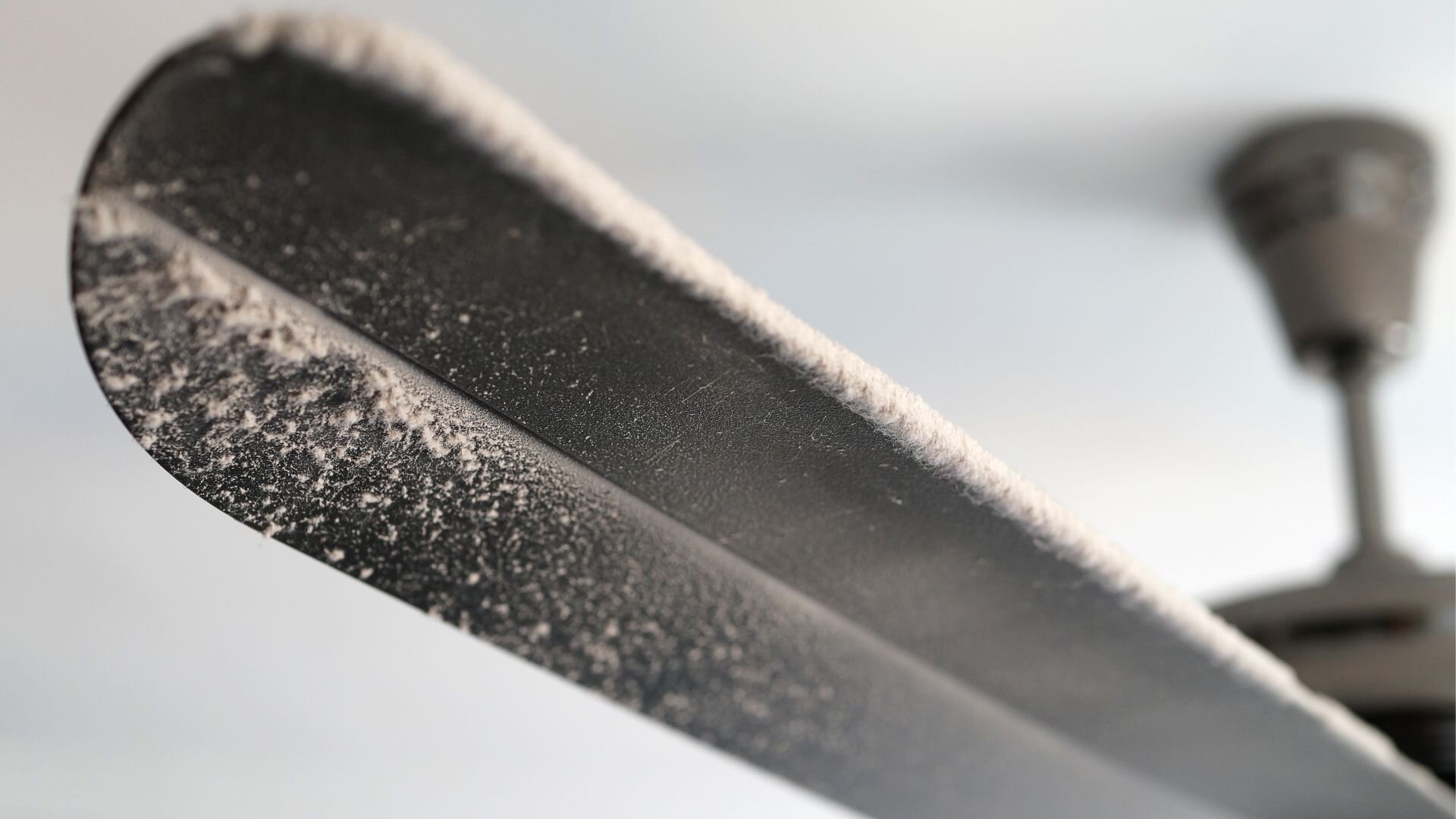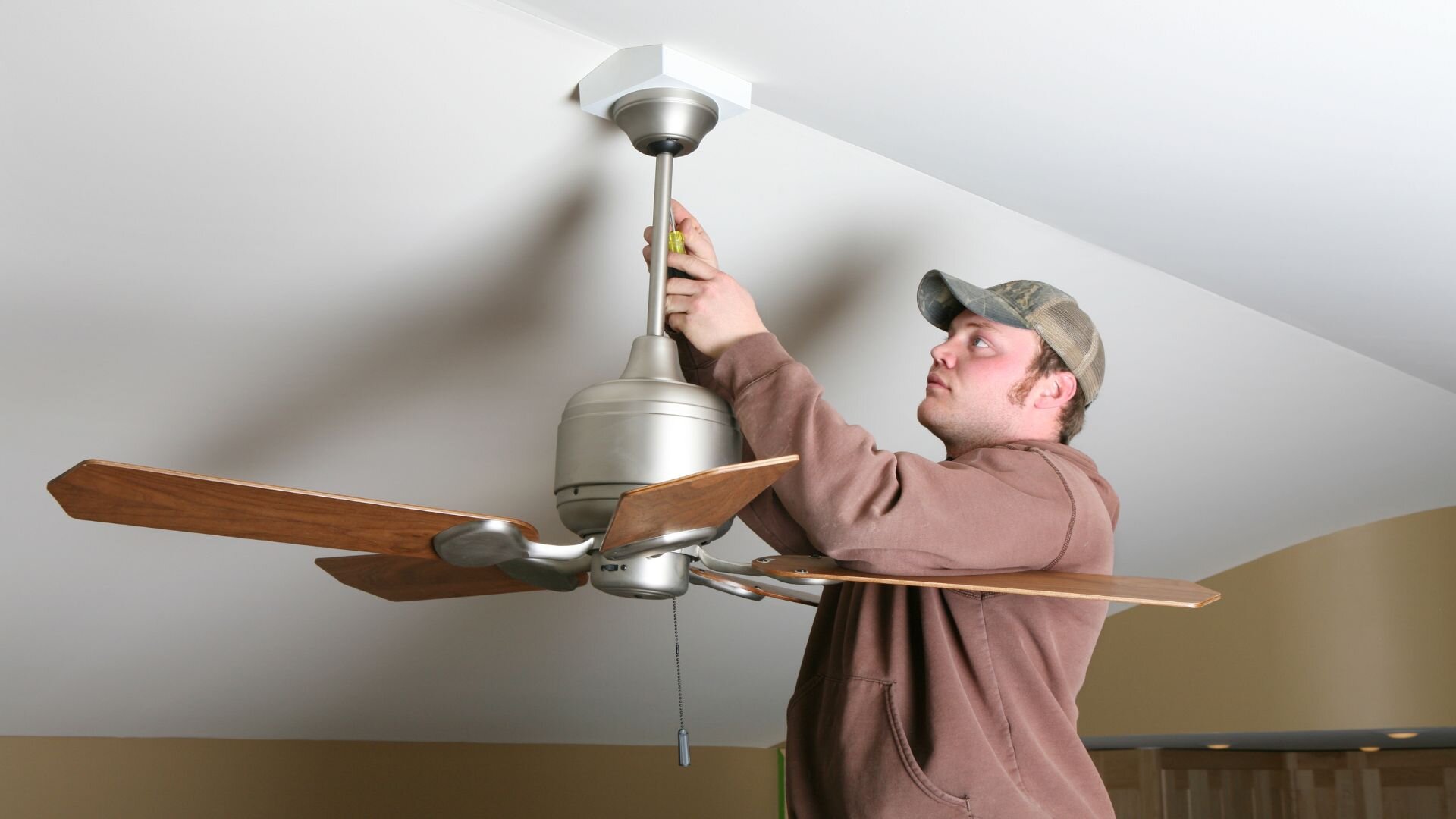Ceiling fans are a smart way to keep cool, using up to 90% less electricity than air conditioning. However, just like any appliance that pulls its weight, they need some tender loving care to operate efficiently.
Looking after your ceiling fan isn’t just about aesthetics—it’s key to ensuring it runs efficiently for ages. Dust and dirt build-up can clog the motor, making it work harder and potentially increasing your power bill.
Over time, that extra strain could lead to expensive repairs. Learn more about residential wiring guide. Giving the blades a quick wipe and tightening a few screws occasionally can keep the air circulating nicely, reducing your dependence on other cooling methods.
If you neglect your ceiling fan, it won’t hesitate to tell you—with wobbling, rattling, and weak airflow. Regularly checking it every few months helps you avoid these issues, ensuring it’s ready to keep you cool when you need it most.
Ceiling fans are a great way to keep cool without breaking the bank—but only if you take care of them. A little maintenance goes a long way in making sure they last, and don’t start driving up your energy costs.
So, before the summer heat hits, give your fan a quick tune-up. It’ll pay you back with breezy, efficient comfort all season long.
Regular Ceiling Fan Check-Ups: Catch Problems Before They Cost You
A bit of regular maintenance does wonders for your ceiling fan’s performance. Spotting small problems early can save you from pricey repairs and keeps your fan functioning effectively—with no surprise breakdowns.

Check for Wobbling and Loose Screws
First things first—turn off the power at the wall switch to stay safe. Then, take a good look at the fan’s motor housing, blades, and light fixtures for any signs of damage.
Loose screws are a common culprit behind wobbly fans, which can mess with airflow and put extra strain on the motor. If your fan isn’t running smoothly, a balancing kit can help get it back on track.
Weird Noises? Don’t Ignore Them
If your ceiling fan begins clicking, buzzing, or grinding, it’s signaling a problem. Consistent noise might indicate a loose part or a motor that needs lubrication. Ignoring it isn’t just irritating—it can increase your energy bill and lead to expensive repairs. Also, check the light kit and bulbs; loose connections might be the culprit.
Check the Electricals
Faulty wiring or loose connections can mess with your fan’s performance and energy efficiency. Make sure the light fixtures and motor housing wiring are secure.
If your fan isn’t responding to the wall switch properly, there could be a power issue. Newer energy-efficient models also have electronic components that might need a quick once-over now and then.
How to Clean Your Ceiling Fan Properly (Without Making a Mess)
A dusty ceiling fan doesn’t just look bad—it can also mess with airflow and energy efficiency. A little regular cleaning keeps it running smoothly and prevents dust from flying around your home. Here’s how to do it the right way.
Turn Off the Power & Grab Your Supplies
First, switch off the power—safety first! Then, gather what you’ll need: a microfibre cloth, a soft brush, a vacuum cleaner with a brush attachment, compressed air, mild dish soap, and a glass cleaner.
If you’re cleaning an outdoor fan, stick to products made for humid conditions to prevent damage.
Clean the Blades Without Spreading Dust Everywhere
Nobody wants a dust shower. Use a microfibre cloth or vacuum attachment to gently remove surface dust.
For a deeper clean, wipe each blade with a damp cloth and a bit of mild dish soap, then dry them completely to prevent moisture damage. Keeping the blades dust-free helps your fan run more efficiently and keeps the air fresh.
Don’t Forget the Motor & Electrical Parts
A dusty motor can slow your fan down, so give it a quick check. Use compressed air to clear out hard-to-reach spots and wipe down delicate electrical parts with a soft cloth.
If your fan has a light kit, take out the light covers and clean them with glass cleaner for a brighter, dust-free shine. While you’re at it, tighten any loose screws to keep everything running smoothly.
A Little Oil Goes a Long Way
If your fan isn’t running as smoothly as it used to, a bit of lubrication might do the trick. Add a few drops of light machine oil to the motor to cut down on friction and extend its lifespan.
A well-oiled fan means better airflow and fewer maintenance headaches down the line.
Keep Your Ceiling Fan Balanced for a Quieter, More Efficient Spin
A wobbly ceiling fan isn’t just annoying—it can also hike up your energy bills and wear out the motor faster. Regular check-ups help keep it steady, ensuring smooth airflow and long-term performance.

Check & Tighten Those Screws
Before making any fixes, switch off the fan and make sure you can reach it safely. Then, inspect the blades, motor, and light kit for loose screws—sometimes even a tiny shift can cause annoying vibrations.
Grab a screwdriver and tighten up any wobbly connections to reduce wear and keep your fan running smoothly.
Stop the Wobble: Balance Your Fan Blades
If your fan shakes when it spins, misaligned blades could be the culprit. First, check for dust build-up—too much grime can throw off the balance.
Wipe each blade with a microfiber cloth and mild soap, making sure not to bend them. Still wobbling? A balancing kit can help even things out, so your fan can move air efficiently without resistance.
Take Care of the Motor—It’s the Heart of Your Ceiling Fan
Your fan’s motor does all the heavy lifting, so a little maintenance goes a long way. Keeping it in top shape helps extend its lifespan and ensures your fan keeps circulating air efficiently.
Does Your Ceiling Fan Need a Tune-Up? Check the Motor
A little routine maintenance can keep your ceiling fan running smoothly and prevent overheating. If your fan is slowing down or making odd noises, the motor might need lubrication—or just a good dusting.
While modern fans are built to be energy-efficient, older models often need more frequent attention. Always check the manufacturer’s guide to see if your fan requires oiling.
Pick the Right Oil—Your Ceiling Fan Will Thank You
Not all oils are created equal. To keep your fan running smoothly, use a non-detergent lubricating oil made specifically for fans—general-purpose oils can attract dust and do more harm than good.
If your fan has a lubrication port, apply a few drops of oil to keep the motor in top shape and prevent unnecessary strain on the blades.
Keep the Motor Clean & Running Smoothly
Turn off the fan before doing any maintenance, then check the wiring and light kit for any obstructions. A dusty motor won’t perform well, so wipe down the exterior with a microfiber cloth. If needed, use a bit of mild dish soap, but be sure to dry everything thoroughly to avoid damage.
Why Motor Maintenance Matters
A well-maintained motor keeps your fan running at full speed, improving airflow and cooling efficiency. During hot weather, this means a stronger breeze—helping you rely less on air conditioning and cut down on energy costs.
With regular upkeep, your fan will work efficiently at any speed and keep your space comfortable year-round.
Adjust Your Ceiling Fan for Every Season & Save on Energy Bills
Your ceiling fan isn’t just for summer—adjusting its settings with the seasons can boost energy efficiency and keep your home comfortable all year round. A quick switch in blade direction can make a big difference in air circulation and energy savings.
Summer: Spin It Anti-Clockwise for a Cool Breeze
When the heat ramps up, adjust your fan to spin anti-clockwise at top speed. This creates a wind chill effect that makes the room feel cooler without lowering the actual temperature.
A properly adjusted fan helps you rely less on air conditioning, which means lower energy bills. If you have a modern fan, check the motor switch or remote control to make sure it’s in the right setting.
Winter: Switch to Clockwise to Stay Warm
When it’s chilly, set your fan to spin clockwise at a low speed. This gently pushes warm air down from the ceiling, helping your heating system work more efficiently. Less strain on your heater means lower energy costs—without sacrificing comfort.
Seasonal Maintenance Keeps Your Fan in Top Shape
Before switching settings for the season, give your fan a quick check-up. Dust buildup on the blades can mess with airflow, so wipe them down with a microfiber cloth.
Check the motor, light kit, and screws to make sure everything’s secure. A little routine maintenance goes a long way in keeping your fan running smoothly for years to come.
Year-Round Comfort with a Simple Fan Adjustment
Switching your fan’s direction with the seasons is an easy way to stay comfortable while saving on energy costs. Whether it’s cooling in summer or circulating warmth in winter, a well-maintained fan keeps your home feeling just right—all year long.
When to Call in the Pros for Ceiling Fan Repairs
Regular upkeep keeps your ceiling fan in good shape, but some problems are best left to the experts. If your fan won’t change speeds, makes strange noises, or the light kit flickers, you could be dealing with an electrical issue that needs professional attention. Ignoring these warning signs can lead to bigger (and more expensive) problems down the track.
If your fan still wobbles after balancing the blades, there could be a bigger issue—like a structural problem. A failing motor or overheating can also mess with airflow and push up your energy bills. While modern fans are built to last, a struggling motor may need repair or even replacement.
Tackling electrical issues yourself can be risky—not to mention, it might do more harm than good. A licensed electrician can diagnose the problem safely, keeping your fan running efficiently and helping it last longer. Getting professional help now can also save you from bigger repair bills later on.
Simple Ways to Keep Your Ceiling Fan Energy-Efficient
Want to cut down on energy costs? Start with small changes—like turning off the fan when you leave a room. If you’re upgrading, consider an energy-efficient model that works with your air conditioning to keep things cool while using less power.
Adjusting your fan’s speed for the season makes a difference—faster in summer for a cooling breeze, slower in winter to push warm air down. Regular cleaning also helps by keeping dust from clogging the motor. A well-maintained fan works more efficiently, saving you money on energy bills.
Let the Experts Keep Your Fan Running Smoothly
A well-maintained fan doesn’t just keep you comfortable—it also saves you money and improves air quality. Regular servicing can extend its lifespan and keep it working efficiently all year round.
At Enersol Electrical, we’re experts in ceiling fan repairs, from fixing motors to troubleshooting electrical issues. Our licensed electricians make sure your fan runs safely and efficiently.
Need help? Get in touch today for expert service and advice tailored to your needs.